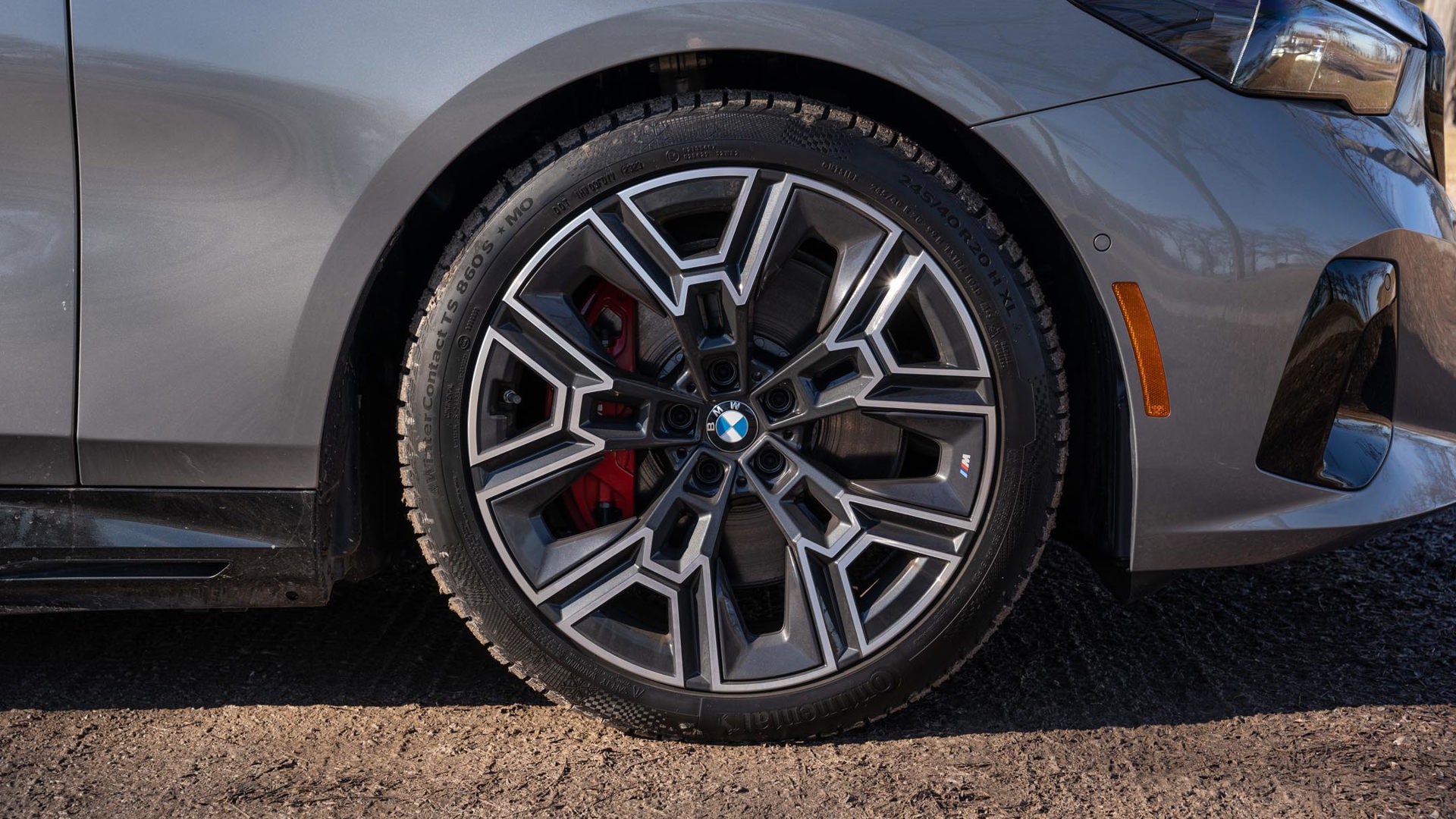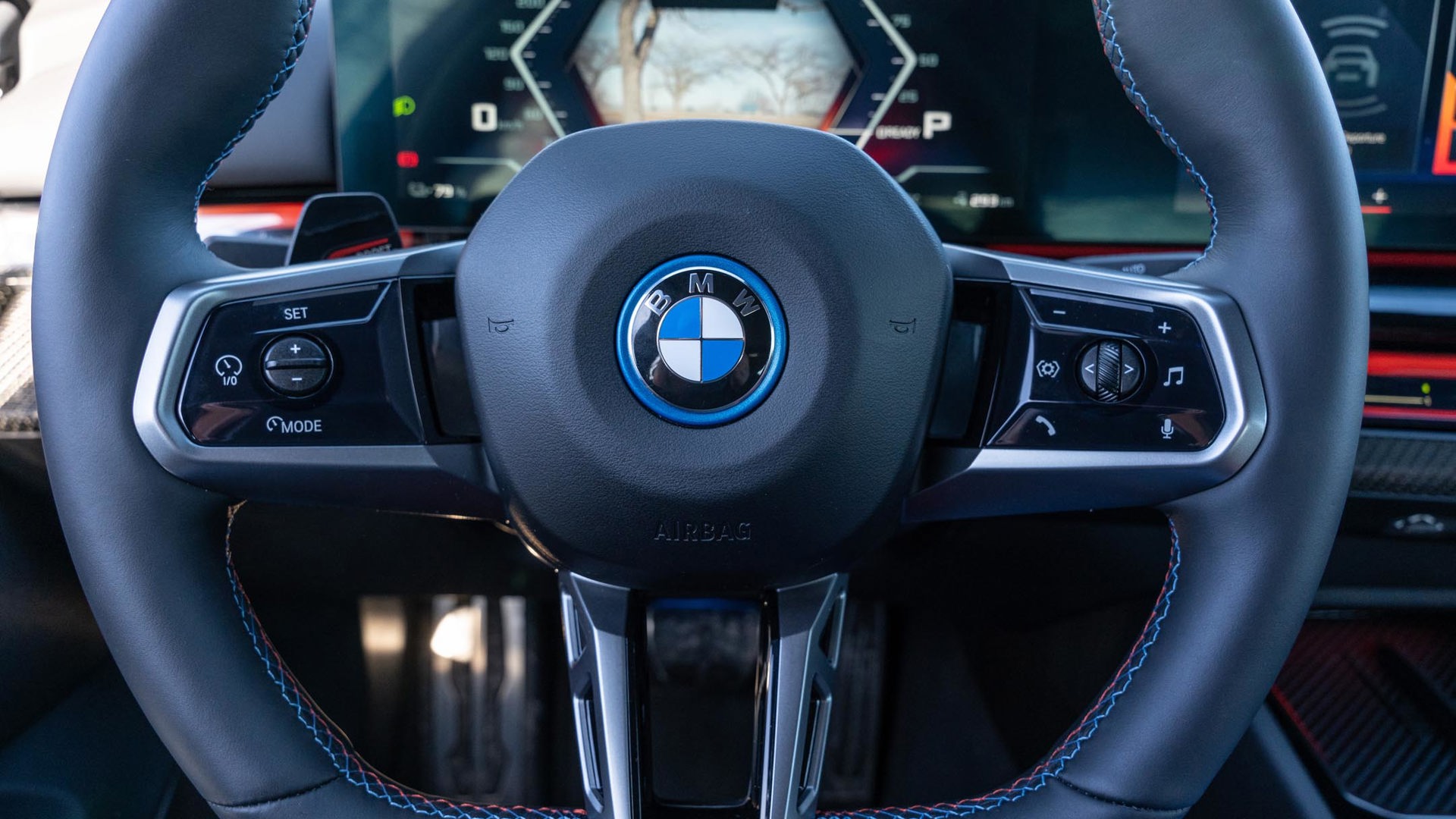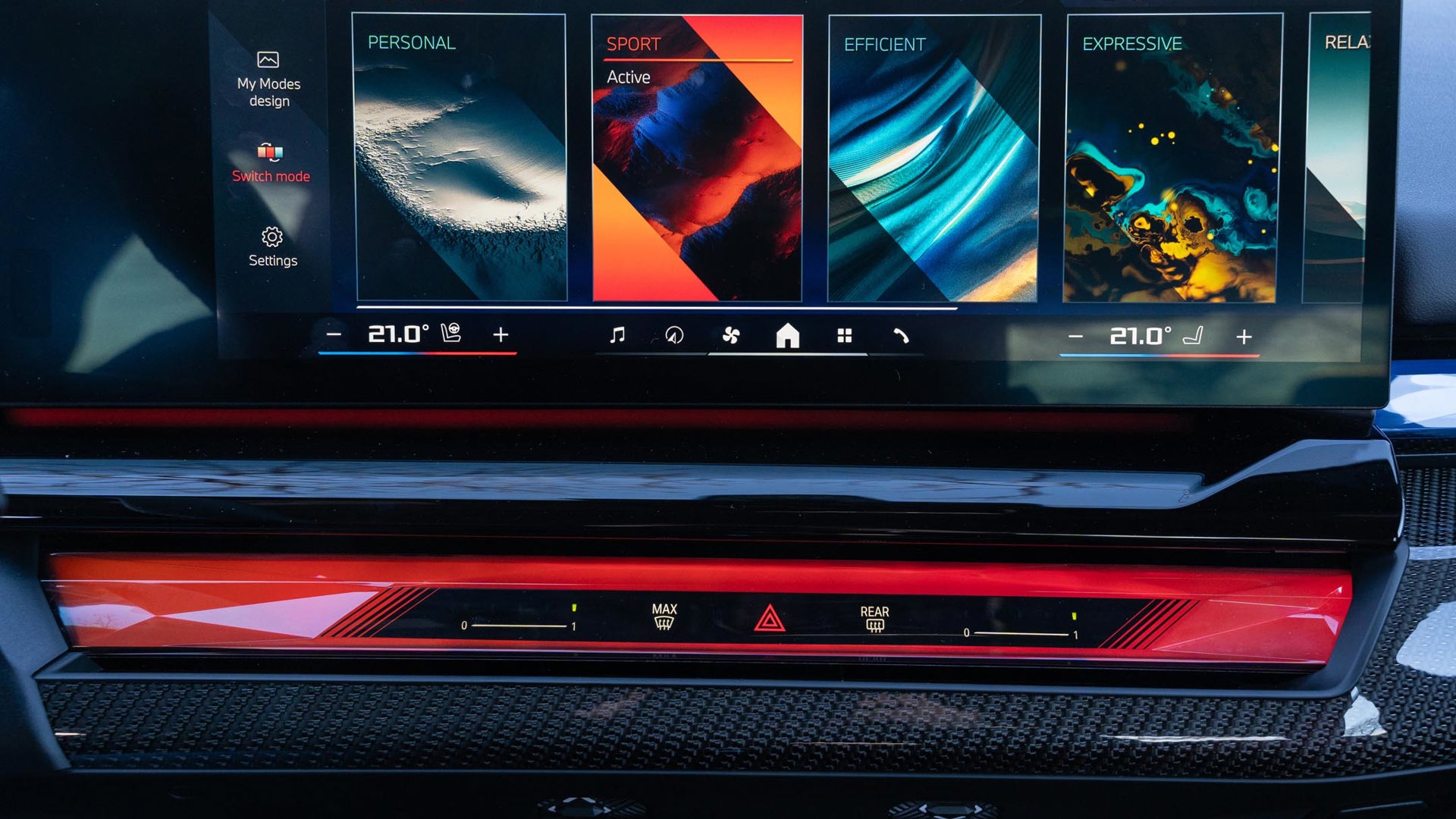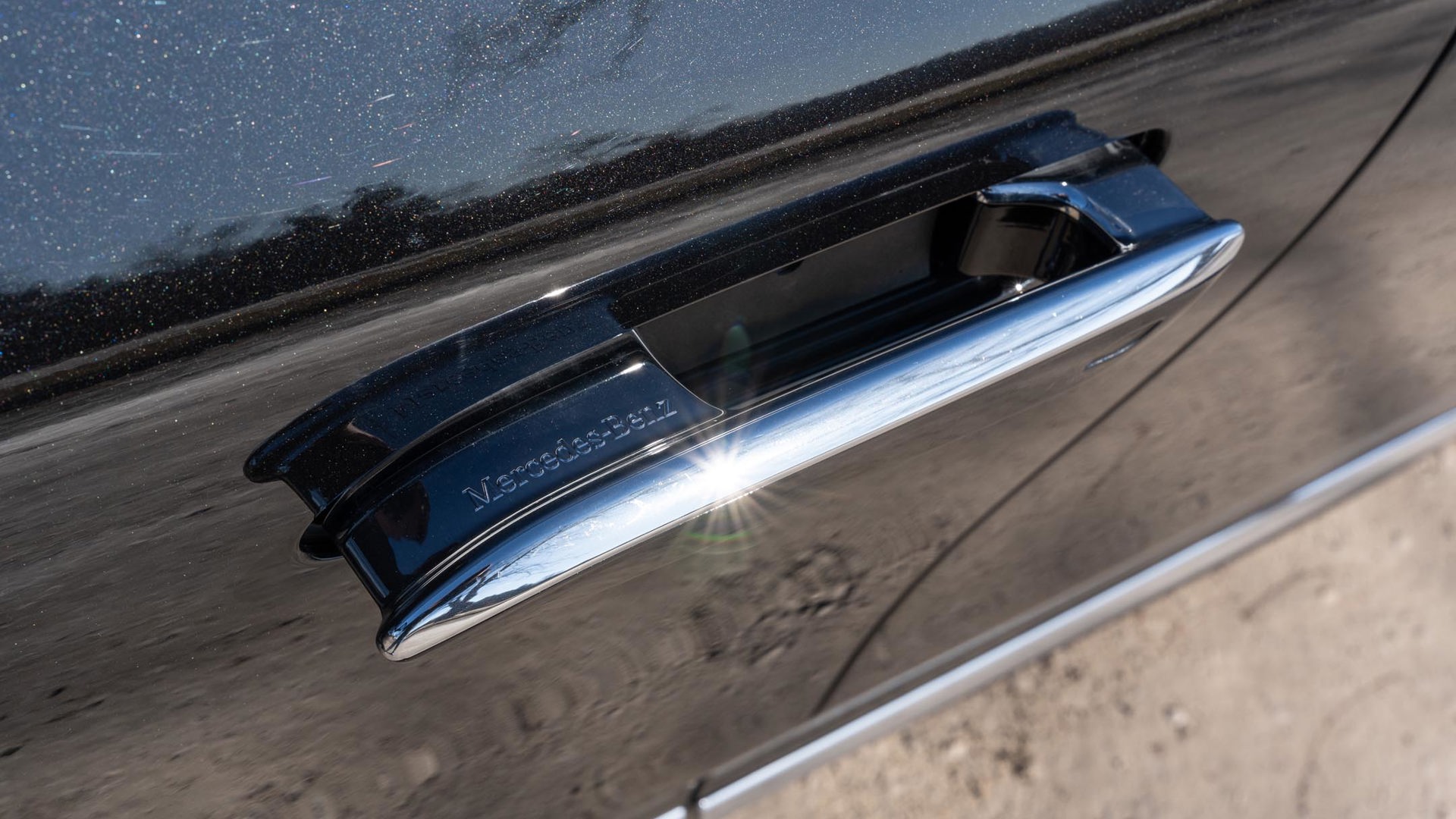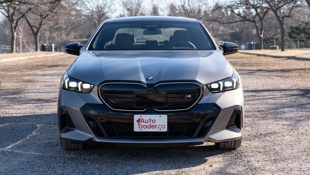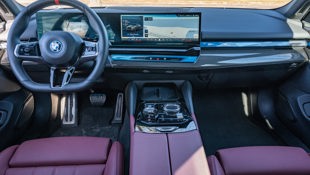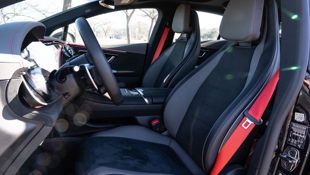Comparison Data
|
2024 BMW i5 M60
|
2024 Mercedes-AMG EQE Sedan
|
|---|---|
|
Engine Displacement
442 kW
|
460 kW
|
|
Engine Cylinders
Dual electric motors, 84.3-kWh battery
|
Dual electric motors, 90-kWh battery
|
|
Peak Horsepower
593 hp
|
617 hp (677 in race start mode)
|
|
Peak Torque
605 lb-ft
|
701 lb-ft (738 in race start mode)
|
|
Fuel Economy
23.5 / 23.4 / 23.5 kWh/100 km, 2.6/2.6/2.6 Le/100 km cty/hwy/cmb; 399 km est. range
|
28.1 / 28.5 / 28.3 kWh/100 km, 3.2 / 3.2 / 3.2 Le/100 km cty/hwy/cmb; 362 km est. range
|
|
Cargo Space
490 L
|
430 L
|
|
Base Price
$95,000
|
$121,500
|
|
A/C Tax
$100
|
$100
|
|
Destination Fee
$2,480
|
$3,665
|
|
Price as Tested
$116,180
|
$140,165
|
|
Optional Equipment
$18,600 – Premium Enhanced Package, $8,100; M Sport Pro Package, $1,500; Advanced Driver Assistance Package, $2,500, High Gloss Carbon Fibre, $1,000; Gloss Controls, $900; Auto 4-zone climate control, $600; Adaptive M Suspension Pro w/ Active Roll Stabilization, $4,000
|
$14,900 – AMG Premium Package, $5,000; MBUX Hyperscreen, $9,900
|
A decade ago, in a comparison test between the then-current BMW 5 Series, Mercedes-Benz E-Class, and Audi A6, we came away marvelling that these swift, stylish, and luxurious sedans could also be so incredibly efficient.
The secret? Each of them had a diesel engine under the hood, and we wondered if it was the turning point at which these machines might finally become popular in North America. Alas, not long after the asteroid known as Dieselgate arrived, most of these compression ignition-fired machines were killed off, or at least left woefully taboo.
The scandal also forced an industry wide shift forward in electrification. While none of the current emissions-free offerings can yet cover 1,000 km on a single charge (although the Lucid Air isn’t far off), the two sedans you see here – the 2024 BMW i5 M60 and 2024 Mercedes-AMG EQE Sedan – are much quicker, quieter, and better equipped than their forebears.
Styling
Despite the modernization of each car, it’s easy to pick out which is the BMW. Blue-and-white roundel badges are affixed front and rear on the i5, and there’s some faint resemblance to the traditional twin-kidney grille in the form of a large plastic panel ringed with LED illumination. There are hints of BMW’s historic dual headlights, too, while the car’s overall profile loosely recalls the shape of past 5 Series models.
The EQE proudly wears its oversized three-pointed star like a medallion, but that’s where the similarity to any past (or present) E-Class ends. While BMW has begun twinning its cars for both gas and electric power, Mercedes has made its EQ offerings distinctly different from their gas-fired equivalents in the lineup.
AutoTrader Editor-in-Chief Jodi Lai suggested the EQE looked like it was melting, and reported its appearance endured negative feedback from other folks who offered their opinions. Perhaps most startling is how much the Mercedes resembles a last-generation Chevrolet Volt in a tuxedo. The BMW didn’t seem to draw much attention at all, perhaps because its drab grey exterior made it largely blend into the winter landscape.
Inside, BMW spiced things up with its leather seats in a deep red hue. The i5’s finishes are top-notch throughout, highlighting its focus on luxury. The dash-wide swath of high-gloss carbon fibre spills onto the doors, contrasted by an elaborate, textured LED light panel and cut-metal speaker grilles. At night, with two big display screens and the mood lighting ablaze, there’s an awful lot illuminated in the BMW, yet it pales in comparison to the IMAX screen that makes up the entire dash of the EQE. Drivers who fantasize about piloting a sci-fi starship will want to opt for the so-called hyperscreen, but for the rest of us, it’s an overwhelming amount of information when it’s on, and a massive pile of smudges and fingerprints when it’s not. Ultimately, neither one of these cars is what we’d call elegant; rather, they’re best described as ultramodern.
BMW i5: 7/10; Mercedes-Benz EQE: 6.5/10
Features
Automotive technology has moved so fast in recent years that listing the entire feature count for these two cars could fill tomes. Both utilize the latest user-interface technology their respective brands have to offer, with available artificial intelligence-enhanced voice commands that help them appropriately respond to statements like “I’m cold” by turning up the cabin heat. There’s route-based adaptive cruise control with hands-free driving on specific highways, and both have sensational audio systems. Heated seats and steering wheels are common to both, as are panoramic sunroofs, sophisticated phone apps that can help plan recharging, and multiple drive modes that enable a driver to customize how lively or subdued each car behaves.
BMW i5: 9/10; Mercedes-Benz EQE: 9/10
User-Friendliness
BMW’s cockpit layout favours visual simplicity, despite an immense amount of functionality available within its infotainment system. The system can be controlled via touchscreen or the crystal dial on the console, and BMW has done a good job of making its menu systems straightforward, while the steering wheel controls are intuitive, too.
By comparison, sitting down at the helm of the Mercedes for the first time is rather overwhelming. The steering wheel alone has four spokes worth of tiny switches and buttons, plus a pair of separate lit-up dials to change up the drive modes. The giant central screen isn’t any trickier to use than BMW’s, but it presents a lot more information all at once. In either case, a buyer should plan to spend considerable time setting up preferences, and be patient when familiarizing oneself with all the options and operations.
A bigger problem is that both cars are now so smart that their features can get in the way of efficient operation. When getting in and out of the EQE to position it for photos, the car would sometimes shut down, announcing it was “Not Ready to Drive” when asked to move again. Much more frustrating are the EQE’s retractable door handles that rarely respond to anything less than two or three taps, pushes, or angry words of persuasion before presenting themselves again. We pity anyone trying to get into their EQE in a rain storm.
The BMW isn’t much better. On a frosty morning, the car was switched on and the front and rear defrosters set, but as soon as the driver exited to start scraping ice from the windows, the car shut down. Had the pre-conditioning been set ahead of time or via the phone app, it would’ve been fine, meaning one’s climate control needs are best scheduled in advance.
Both cars offer great driving positions, putting their giant screens in easy reach, and elaborate gauge displays presenting everything a driver could ever want to know. The squared-off graphics BMW has been using for a few years aren’t as pleasing or easy-to-read at a glance as the EQE’s depiction of graphic round gauges, but the BMW’s outward visibility, especially to the rear three-quarter and rear view, is significantly better than the Mercedes.
BMW i5: 7/10; Mercedes-Benz EQE: 6/10
Comfort
The i5’s seats offer plenty of adjustability and support, but they’re more firm than supple. By comparison, the EQE’s seats are much sportier with bolder side bolsters that, when coupled with the faux-suede finish, provide a big bear hug for the driver. The BMW’s rear seat is notably more spacious than the one in the Mercedes, which is not only scant on headroom, but claustrophobic thanks to the squat windows.
Electrification works well for luxury cars because of the inherent smoothness and serenity. With no engines to grumble and vibrate, both of these cars whir along peacefully at highway speed. While the EQE’s adaptive suspension always feels firm, the i5’s ride is astonishingly good. In sport mode it’s firm but far from punishing the way BMW’s sporty suspensions used to be, but in comfort mode the i5 calmly wafts along, effortlessly soaking up every major bump. Considering the Bimmer rolls on low-profile tires wrapped around big 20-inch wheels makes the ride quality all the more impressive.
BMW i5: 9/10; Mercedes-Benz EQE: 8.5/10
Practicality
Both cars can zip through traffic effortlessly, or cruise comfortably in the carpool lane, audio system pounding. Granted, range will be reduced in the winter months, and neither car has the elevated ride height of an SUV to manage deep snow, but as an alternative to the gas-powered sedan equivalents from either brand, these make an excellent daily executive express.
Both trunks are decently spacious – the BMW with an extra 60 L of space – and both offer split-folding rear seats for larger loads. The Mercedes will even electrically fold its rear seats at the touch of trunk-lid-mounted buttons, while the BMW requires the pull of a lever to do so. The i5’s more spacious cabin is what makes it the more practical car.
BMW i5: 7/10; Mercedes-Benz EQE: 6.5/10
Power
If the goal is to use your six-figure luxury sedan for drag racing, the EQE is the better bet. Mercedes claims it’ll reach 100 km/h in a scorching 3.5 seconds. The Bimmer, meanwhile, needs an extra blink to get there, doing it in a claimed 3.8 seconds. In reality, it’s like assessing whether a lightning strike is quicker than a sneeze. Both are dizzyingly quick and can squirt through traffic in an almost cartoon-like way. Supercars and Hellcats should think twice before trying to beat either car to the end of the merge lane.
Braggards will find the EQE’s 617 hp and 701 lb-ft of torque (boosted to 677 hp and 738 lb-ft in race start mode) more boastful than the i5’s 593 hp and 549 lb-ft of torque (which can be briefly boosted to 605 lb-ft).
Numbers aside, it’s the feel of the colossal and instantaneous thrust that makes these cars surprisingly fun and addictive to drive. Both offer synthesized sounds that, while not replacing the metal music generated from the engines of traditional BMW M and Mercedes-AMG cars, nevertheless do add to the excitement here.
BMW i5: 9/10; Mercedes-Benz EQE: 9.5/10
Driving Feel
Traditionalists still aren’t convinced that an electric vehicle (EV) can be a replacement for their gas-powered performance counterparts, but these two machines could help change that tune. The i5 M60 and AMG EQE provide exceptional grip and fantastic balance, even when being hustled around tight country roads and roundabouts. Even tight turns were easily navigated with the help of four-wheel steering in both machines.
Both cars could benefit from more steering feel, with the EQE feeling artificially heavy, while the i5 is overboosted and light. The benefit to the latter, especially with its quick, adaptive steering ratio, is that the Bimmer drives smaller, nimbler and much lighter than its 130-kg (287-lb) advantage over the Mercedes should dictate.
The driving feel of all but very few contemporary performance cars is rather digital and distant, but while the BMW’s braking at least feels strong progressive, the Mercedes’s braking was fierce when needed, but its braking feel – and even how much pedal pressure was needed – was wildly inconsistent.
BMW i5: 8.5/10; Mercedes-Benz EQE: 7/10
Fuel Economy
With more mass and higher motor output (460 kW versus 442), it’s unsurprising the Mercedes consumes more lightning bolts than the BMW. At a combined figure of 3.2 Le/100km, the EQE isn’t as efficient as the i5’s 2.6 figure. Natural Resources Canada’s calculations suggest this will cost the EQE owner $906 a year versus $752 to energize the i5 – hardly enough of a difference to choose one of these six-figure cars over the other.
In terms of range, it’s a similar story. Under optimal conditions, the EQE with its 90.6-kWh battery is rated for 362 km, compared to the i5’s 84-kWh battery and 399 km. Neither car seemed overly affected by the winter tires fitted, nor the mild winter conditions.
Drivers lucky enough to find a functional high-speed public charger can expect to see charge speeds up to 170 kW for the Mercedes versus 205 kW for the BMW.
BMW i5: 9/10; Mercedes-Benz EQE: 8.5/10
Safety
Both cars are equipped with robust structures, a cocoon of air bags, plus a litany of advanced safety aids. Of note, both cars offer advanced detection sensors for collision avoidance and automated braking, plus blind-spot monitoring, lane-tracing, and automated lane-change assist.
BMW i5: 9/10; Mercedes-Benz EQE: 9/10
Value
Up to this point, aside from the EQE’s sizable power advantage, the i5 M60 has proven to be the AMG’s equal or better in every measure, but when factoring in pricing, the BMW’s advantage becomes dramatic. Starting at $121,500, the Mercedes’s base price is $8,000 dearer than the fully optioned BMW at $113,600. Although the BMW’s cost starts at $95,000, some of the pricey optional packages should be considered essential for fairly fundamental features like heated front and rear seats. Likewise, given how well it works, the $4,000 adaptive suspension option is a must-have, too.
BMW i5: 7.5/10; Mercedes-Benz EQE: 6/10
The Verdict
When testing the diesel-powered predecessors to the machines here, a competitive electric version wasn’t even imaginable, let alone ones as blazingly quick or impressively equipped. We’re grateful both BMW and Mercedes continue to offer sedans this size with gas engines alongside these new electrified offerings, but for buyers seeking a very swift, well-built, premium electric sedan, both the 2024 Mercedes-AMG EQE and BMW i5 M60 are well worth considering. For our pick, when factoring in its more usable interior, better styling, and of course, its considerably better value, the BMW becomes the obvious choice.












